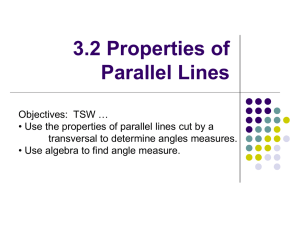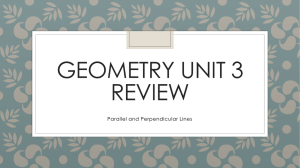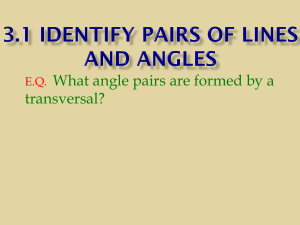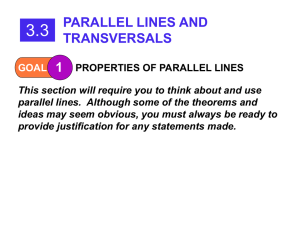Algebra 2B Notes
advertisement
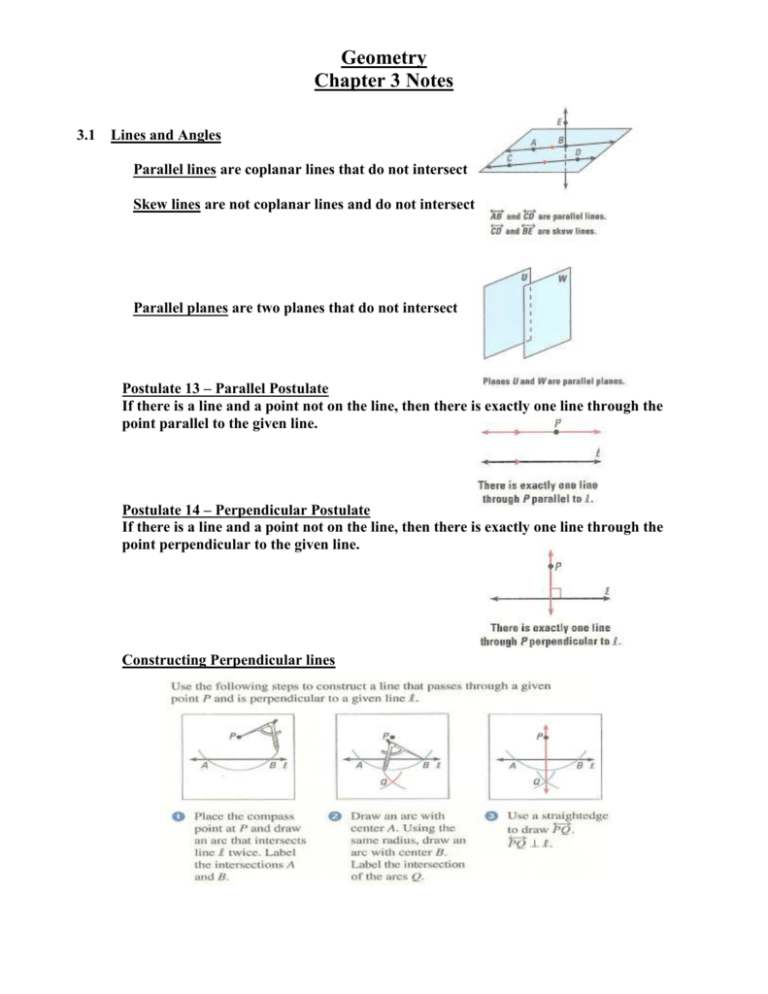
Geometry Chapter 3 Notes 3.1 Lines and Angles Parallel lines are coplanar lines that do not intersect Skew lines are not coplanar lines and do not intersect Parallel planes are two planes that do not intersect Postulate 13 – Parallel Postulate If there is a line and a point not on the line, then there is exactly one line through the point parallel to the given line. Postulate 14 – Perpendicular Postulate If there is a line and a point not on the line, then there is exactly one line through the point perpendicular to the given line. Constructing Perpendicular lines A Transversal is a line that intersects two or more coplanar lines at different points. Two angles are corresponding angles if they occupy corresponding positions. Angles 1 & 5 are corresponding angles Two angles are alternate exterior angles if they lie outside the two lines on opposite sides of the transversal. Angles 1 & 8 are alternate exterior angles. Two angles are alternate interior angles if they lie between the two lines on opposite sides of the transversal. Angles 3 & 6 are alternate interior angles. Two angles are consecutive interior angles if they lie between the two lines on the same side of the transversal. Angles 3 & 5 are consecutive interior angles. 3.2 Proof and Perpendicular Lines Theorem 3.1 – If two lines intersect to form a linear pair of congruent angles, then the lines are perpendicular. Theorem 3.2 – If two sides of two adjacent acute angles are perpendicular, then the angles are complementary. Theorem 3.3 – If two lines are perpendicular, then they intersect to form four right angles. Types of Proofs (Two-Column, Paragraph, Flow) 3.3 Parallel Lines and Transversals Postulate 15 – Corresponding Angles Postulate If two parallel lines are cut by a transversal, then the pairs of corresponding angles are congruent. Theorem 3.4 – Alternate Interior Angles If two parallel lines are cut by a transversal, then the pairs of alternate interior angles are congruent. Theorem 3.5 – Consecutive Interior Angles If two parallel lines are cut by a transversal, then the pairs of consecutive interior angles are supplementary Theorem 3.6 – Alternate Exterior Angles Converse If two parallel lines are cut by a transversal, then the pairs of alternate exterior angles are congruent. Theorem 3.7 – Perpendicular Transversal If a transversal is perpendicular to one of the two parallel lines, then it is perpendicular to the other. 3.4 Proving Lines are Parallel Postulate 16 – Corresponding Angles Converse If two lines are cut by a transversal so that corresponding angles are congruent, then the lines are parallel. Theorem 3.8 – Alternate Interior Angles Converse If two lines are cut by a transversal so that alternate interior angles are congruent, then the lines are parallel. Theorem 3.9 – Consecutive Interior Angles Converse If two lines are cut by a transversal so that consecutive interior angles are supplementary, then the lines are parallel. Theorem 3.10 – Alternate Exterior Angles Converse If two lines are cut by a transversal so that alternate exterior angles are congruent, then The lines are parallel. 3.5 Using Properties of Parallel Lines Theorem 3.11 – If two lines are parallel to the same line, then they are parallel to each other. Theorem 3.12 – In a plane, if two lines are perpendicular to the same line, then they are parallel to each other 3.6 Parallel Lines in the Coordinate Plane Slope-Intercept form Postulate 17 – Slopes of Parallel Lines In a coordinate plane, two nonvertical lines are parallel if and only if they have the same slope. Any two vertical lines are parallel 3.7 Perpendicular Lines in the Coordinate Plane Postulate 18 – Slopes of Perpendicular Lines In a coordinate plane, two nonvertical lines are perpendicular if and only if the product of their slopes is -1. Vertical and horizontal lines are perpendicular.




